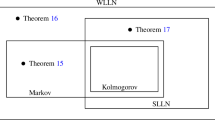Abstract
A 0–1probability space is a probability space (Ω, 2Ω,P), where the sample space Ω⊂-{0, 1}n for somen. A probability space isk-wise independent if, whenY i is defined to be theith coordinate or the randomn-vector, then any subset ofk of theY i 's is (mutually) independent, and it is said to be a probability spacefor p 1,p 2, ...,p n ifP[Y i =1]=p i .
We study constructions ofk-wise independent 0–1 probability spaces in which thep i 's are arbitrary. It was known that for anyp 1,p 2, ...,p n , ak-wise independent probability space of size\(m(n,k) = \left( {\begin{array}{*{20}c} n \\ k \\ \end{array} } \right) + \left( {\begin{array}{*{20}c} n \\ {k - 1} \\ \end{array} } \right) + \left( {\begin{array}{*{20}c} n \\ {k - 2} \\ \end{array} } \right) + ... + \left( {\begin{array}{*{20}c} n \\ 0 \\ \end{array} } \right)\) always exists. We prove that for somep 1,p 2, ...,p n ∈ [0,1],m(n,k) is a lower bound on the size of anyk-wise independent 0–1 probability space. For each fixedk, we prove that everyk-wise independent 0–1 probability space when eachp i =k/n has size Ω(n k ). For a very large degree of independence —k=[αn], for α>1/2- and allp i =1/2, we prove a lower bound on the size of\(2^n \left( {1 - \frac{1}{{2\alpha }}} \right)\). We also give explicit constructions ofk-wise independent 0–1 probability spaces.
Similar content being viewed by others
References
N. Alon, L. Babai, andA. Itai: A Fast and Simple Randomized Parallel Algorithm for the Maximal Independent Set Problem,Journal of Algorithms,7 (1986), 567–583.
N. Alon, andJ. Spencer:The Probabilistic Method, Wiley, 1992.
B. Berger, andJ. Rompel: Simulating (log c n)-wise Independence in NC,Proc. 30 th IEEE Symposium on Foundations of Computer Science, 1989, 2–7.
B. Chor, O. Goldreich, J. Håstad, J. Friedman, S. Rudich, andR. Smolensky: The Bit Extraction Problem ort-Resilient Functions,Proc. 26 th IEEE Symposium on Foundations of Computer Science, 1985, 396–407.
J. Friedman: On the Bit Extraction Problem,Proc. 33rd IEEE Symposium on Foundations of Computer Science, 1992, 314–319.
A. Joffe: On a Set of Almost Deterministick-Independent Random Variables,Annals of Probability,2 (1974), 161–162.
D. Koller, andN. Megiddo: Constructing Small Sample Spaces Satisfying Given Constraints,Proc. 25 th ACM Symposium on Theory of Computing, 1993, 268–277.
M. Luby: A Simple Parallel Algorithm for the Maximal Independent Set Problem,SIAM Journal on Computing,15 (1986), 1036–1053.
M. Luby: Removing Randomness in Parallel Computation Without a Processor Penalty,Proc. 29 th IEEE Symposium on Foundations of Computer Science, 1988, 162–173.
R. Motwani, J. Naor, andJ. Naor: The Probabilistic Method Yields Deterministic Parallel Algorithms,Proc. 30 th IEEE Symposium on Foundations of Computer Science, 1989, 8–13.
L. Schulman: Sample Spaces Uniform on Neighborhoods,Proc. 24 th ACM Symposium on Theory of Computing, 1992, 17–25.
Author information
Authors and Affiliations
Additional information
This author was supported in part by NSF grant CCR 9107349.
This research was supported in part by the Israel Science Foundation administered by the lsrael Academy of Science and Humanities and by a grant of the Israeli Ministry of Science and Technology.



